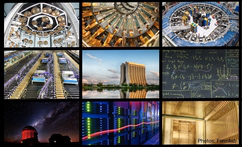Speaker
Description
The Mu2e experiment aims to search for the CLFV neutrinoless, coherent conversion process of muons into electrons, in the field of a nucleus. The goal of our work is to enhance the Offline event display of the experiment, developed using the ROOT based 3-D event visualisation framework called TEve. New features have been added to the existing display and further improvements are underway to make the display more detailed and inclusive of all parts of the experiment. The additional GUI selections cater to the users and developers of various sections of the Mu2e. The Upstream module : Production and Transport solenoids, have been added to the display, which was solely focused on the Detector Solenoid before. The addition of the upstream Monte Carlo tracks enable a complete illustration of the experiment. It could be beneficial in understanding the processes occurring at the Production Solenoid more clearly and to follow the trajectory of muons from the production region to the muon stopping target, where the conversion may take place. The tracks have been colour coded according to their particle ID and a PID based track selection panel has been included for the user. A better matching of the Monte Carlo truth and reconstructed tracks has been achieved as well by using the Kalman filtered segments of the reconstructed helix rather than an approximation which was used earlier while extracting the fit information. The display, particularly the 2-D projections, have been enhanced by the addition of the geometrical features like the stopping target, tracker planes and highlighting of the straws which have been hit. The development of the 2-D visualisation of the Cosmic Ray Veto system is in progress. This visual aid should help in understanding the background due to the cosmic muons better.
